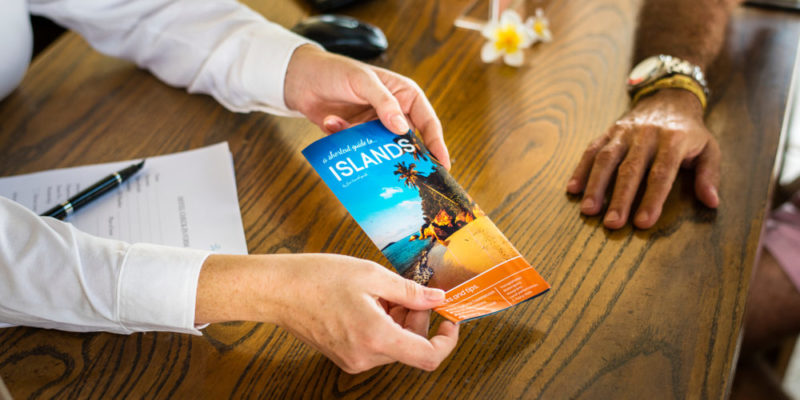We explain what a triptych is, what its structure is like and what it is for. Also, what are its general characteristics and the types that exist.
What is a triptych?
A triptych is called a visual composition that consists of three concatenated parts , capable of folding on itself. The term comes from the ancient Greek triptychos , composed of tri- (“three”) and ptyché (“to fold”), and is generally used for two types of object:
- Triptych (art). A work of plastic arts, generally painting and sculpture , which is divided into three sections or panels generally carved from wood or some other support material. The center panel is usually larger and the sides fold over it, often revealing, when closed, a fourth work of art. It was extremely common in Flemish painting of the 15th and 16th centuries.
- Triptych (advertising). This is the name given to an information brochure printed on a sheet folded in three parts, in which both sides of the sheet are used to, together with the fold, obtain six printable sides.
See also: Website
Measurements of a triptych
 A triptych is made from a DIN A4 size sheet of paper (ie: 297 x 210 mm).
A triptych is made from a DIN A4 size sheet of paper (ie: 297 x 210 mm).This sheet must be placed horizontally to fold it into three identical parts (99 x 210 mm) which will be the six pages available to place the information.
Structure of the triptych
As we said before, a triptych is folded into three identical parts from an A4 sheet in a horizontal position. This will result in six available blades : three inside and three outside.When the triptych is folded, two of the exteriors remain visible , while the rest are hidden inside.
What does a triptych contain?
 Usually, the information contained in a triptych is divided according to its structure. The visible faces when folding are usually the cover and the closure . The first one carries the elements of identification of what the brochure contains. The other visible side includes information on who makes it, why, where to go for more information, etc.
Usually, the information contained in a triptych is divided according to its structure. The visible faces when folding are usually the cover and the closure . The first one carries the elements of identification of what the brochure contains. The other visible side includes information on who makes it, why, where to go for more information, etc.The remaining four pages, which are internal , are ideal for displaying specific information, always going from the most general to the most specific.
Since it is a brochure and not an article , the ideal thing is that the information is condensed and abbreviated, even outlined. In this way, the least amount of space is taken up. Thus, a graphic or visual accompaniment can be included: photographs , images, fonts, labeling, etc.
These four internal pages are generally organized like this:
- Page 2 (after the cover). Introduction to the topic or general perspective.
- Page 3 and 4. Development of the specific topic.
- Page 5. Conclusions , closing or recommendations (the second external page can be used if necessary).
What is the function of a triptych?
 A triptych is an advertising brochure in which there is a sample of organized and interesting information on a topic, without going too deep. In addition, it includes the contact details of the organization that manufactures it or the places where you can go for more information, such as telephone numbers, addresses, emails , web pages , etc.
A triptych is an advertising brochure in which there is a sample of organized and interesting information on a topic, without going too deep. In addition, it includes the contact details of the organization that manufactures it or the places where you can go for more information, such as telephone numbers, addresses, emails , web pages , etc.
How do you fold a triptych?
 The triptychs can be folded in two ways, depending on the distribution of the information on their sheets. Remember that the important thing is that the content reaches the reader in the most presentable, orderly and coherent way possible.
The triptychs can be folded in two ways, depending on the distribution of the information on their sheets. Remember that the important thing is that the content reaches the reader in the most presentable, orderly and coherent way possible.
- Way 1: wrap-around fold. Using the central space as the background of the triptych, the side sheets are folded over, giving the appearance of a small envelope that the reader must open to access the information.
- Way 2: accordion folded. As its name implies, it makes the triptych a small spring or accordion, in the shape of an "s", placing one end of the paper above the others, as if it were a small book.
Design for a triptych
Brochures can be designed the way we see fit . For example, the sheets can be printed in a certain color, and photographs, images, motifs of more or less elaborate graphic design can be added. It all depends on what impression we want to make on the reader.
Types of triptych
There are usually three triptych formats:
- Advertising. In which photos, images abound and focus on the promotion of a service or product that is marketed.
- Informative. In which the reader is provided with a condensation of pertinent information on health, tourism and other relevant aspects.
- Artistic. In which the reader is offered an aesthetic experience, more than informative, through designs, poetic texts, etc.
How are triptychs made?
The triptychs can be made manually or by hand , folding a paper after having printed or written it manually, especially if it is a school task. For this there are computer programs such as Office, Photoshop or Canva.They can also be done industrially , by going to a printing service agency, where they have the technology to print and fold the triptychs, guaranteeing the best possible result.
Keys to a good triptych
 To make a good triptych, keep the following considerations in mind:
To make a good triptych, keep the following considerations in mind:
- Anticipate and organize content. Consider the reader's experience and organize the information so that it is engaging, simple, and enjoyable, rather than chaotic or overwhelming.
- Think of your target audience. It is much more difficult to reach your ideal reader if you have no idea who they are: buyers of your company ? Schoolmates? Possible recruits for your judo club?
- Summarize, simplify and accompany with color. Just because your brochure is informative doesn't mean it should be boring. If someone wants to read a book about it, they will look for it, but your job is to give them only the clues they need to get an idea or arouse their interest. The design of the triptych should contribute to this.
The above content published at Collaborative Research Group is for informational and educational purposes only and has been developed by referring reliable sources and recommendations from technology experts. We do not have any contact with official entities nor do we intend to replace the information that they emit.
Anas is an editor of a prestigious publishing company in the United States. She studied Mathematics in Arizona. Anas is also a teacher and one of her long-term goals is to build an institution that offers free education to everyone who are financially not stable. .
Leave a reply
Your email address will not be published. Required fields are marked *Recent post

Sport: What Is It, Types, Risks, Features, Characteristics and Examples

Dogs: Emergence, Features, Characteristics, Feeding and Breeds

Story: Definition, Elements, Structure, Features and Characteristics

